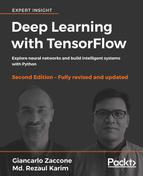- A rudimentary level of programming in one language is assumed, as is a basic familiarity with computer science techniques and technologies, including a basic awareness of computer hardware and algorithms. Some competence in mathematics is needed to the level of elementary linear algebra and calculus.
- Software: Python 3.5.0, Pip, pandas, numpy, tensorflow, Matplotlib 2.1.1, IPython, Scipy 0.19.0, sklearn, seaborn, tffm, and many more
- Step: Issue the following command on Terminal on Ubuntu:
$ sudo pip3 install pandas numpy tensorflow sklearn seaborn tffmNevertheless, installing guidelines are provided in the chapters.
You can download the example code files for this book from your account at http://www.packtpub.com. If you purchased this book elsewhere, you can visit http://www.packtpub.com/support and register to have the files emailed directly to you.
You can download the code files by following these steps:
- Log in or register at http://www.packtpub.com.
- Select the SUPPORT tab.
- Click on Code Downloads & Errata.
- Enter the name of the book in the Search box and follow the on-screen instructions.
Once the file is downloaded, please make sure that you unzip or extract the folder using the latest version of any of the following:
- WinRAR / 7-Zip for Windows
- Zipeg / iZip / UnRarX for macOS
- 7-Zip / PeaZip for Linux
The code bundle for the book is also hosted on GitHub at https://github.com/PacktPublishing/Deep-Learning-with-TensorFlow-Second-Edition. We also have other code bundles from our rich catalog of books and videos available at https://github.com/PacktPublishing/. Check them out!
We also provide a PDF file that has color images of the screenshots/diagrams used in this book. You can download it here: https://www.packtpub.com/sites/default/files/downloads/DeepLearningwithTensorFlowSecondEdition_ColorImages.pdf.
There are a number of text conventions used throughout this book.
CodeInText: Indicates code words in text, database table names, folder names, filenames, file extensions, pathnames, dummy URLs, user input, and Twitter handles. For example; " This means that using tf.enable_eager_execution() is recommended."
A block of code is set as follows:
import tensorflow as tf # Import TensorFlow
x = tf.constant(8) # X op
y = tf.constant(9) # Y op
z = tf.multiply(x, y) # New op Z
sess = tf.Session() # Create TensorFlow session
out_z = sess.run(z) # execute Z op
sess.close() # Close TensorFlow session
print('The multiplication of x and y: %d' % out_z)# print resultWhen we wish to draw your attention to a particular part of a code block, the relevant lines or items are set in bold:
import tensorflow as tf # Import TensorFlow
x = tf.constant(8) # X op
y = tf.constant(9) # Y op
z = tf.multiply(x, y) # New op Z
sess = tf.Session() # Create TensorFlow session
out_z = sess.run(z) # execute Z op
sess.close() # Close TensorFlow session
print('The multiplication of x and y: %d' % out_z)# print resultAny command-line input or output is written as follows:
>>> MSE: 27.3749
Bold: Indicates a new term, an important word, or words that you see on the screen, for example, in menus or dialog boxes, also appear in the text like this. For example: " Now let's move to http://localhost:6006 and on click on the GRAPH tab."
